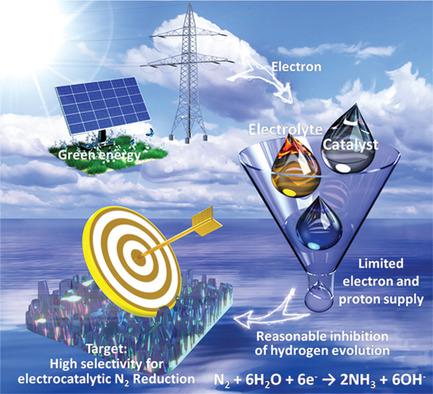当前位置:
X-MOL 学术
›
Small Methods
›
论文详情
Our official English website, www.x-mol.net, welcomes your feedback! (Note: you will need to create a separate account there.)
Advances in Electrocatalytic N2 Reduction—Strategies to Tackle the Selectivity Challenge
Small Methods ( IF 12.4 ) Pub Date : 2018-10-26 , DOI: 10.1002/smtd.201800337 Gao‐Feng Chen 1 , Shiyu Ren 1 , Lili Zhang 1 , Hui Cheng 1 , Yaru Luo 1 , Kehan Zhu 1 , Liang‐Xin Ding 1 , Haihui Wang 1
Small Methods ( IF 12.4 ) Pub Date : 2018-10-26 , DOI: 10.1002/smtd.201800337 Gao‐Feng Chen 1 , Shiyu Ren 1 , Lili Zhang 1 , Hui Cheng 1 , Yaru Luo 1 , Kehan Zhu 1 , Liang‐Xin Ding 1 , Haihui Wang 1
Affiliation

|
The industrial process used to reduce N2 to NH3, typically the Haber–Bosch process, is energy‐intensive and highly dependent on fossil fuels, a major source of greenhouse gas emissions causing undesirable climate change. Electrochemical reduction of N2 to NH3 using renewable energy is one attractive approach to address this problem. A major challenge for electrochemical nitrogen reduction reaction (NRR) is low catalytic activity, accompanied by ultralow selectivity. Current studies have made some breakthroughs in Faradaic efficiency, with reasonable current density, while remaining far from satisfying the needs of commercial applications. This review discusses current strategies, focusing on the perspectives of catalyst design, cell configuration, electrolyte choice, etc., to tackle the selectivity challenge. In addition, rigorous control experiments to eliminate possible ammonia contamination and standard ammonia detection methods to ensure data accuracy are proposed, providing guidance for the field of NRR studies.
中文翻译:

电催化氮还原的研究进展-解决选择性挑战的策略
用于将N 2还原为NH 3的工业过程(通常为Haber–Bosch过程)是能源密集型的,并且高度依赖化石燃料,而化石燃料是导致不良的气候变化的主要温室气体排放源。N 2电化学还原为NH 3使用可再生能源是解决这个问题的一种有吸引力的方法。电化学氮还原反应(NRR)的主要挑战是催化活性低,同时具有超低的选择性。当前的研究在合理的电流密度下在法拉第效率上取得了一些突破,同时还远远不能满足商业应用的需求。这篇综述讨论了当前的策略,重点放在催化剂设计,电池配置,电解质选择等方面,以解决选择性挑战。此外,提出了用于消除可能的氨污染的严格控制实验和确保数据准确性的标准氨检测方法,为NRR研究领域提供了指导。
更新日期:2018-10-26
中文翻译:

电催化氮还原的研究进展-解决选择性挑战的策略
用于将N 2还原为NH 3的工业过程(通常为Haber–Bosch过程)是能源密集型的,并且高度依赖化石燃料,而化石燃料是导致不良的气候变化的主要温室气体排放源。N 2电化学还原为NH 3使用可再生能源是解决这个问题的一种有吸引力的方法。电化学氮还原反应(NRR)的主要挑战是催化活性低,同时具有超低的选择性。当前的研究在合理的电流密度下在法拉第效率上取得了一些突破,同时还远远不能满足商业应用的需求。这篇综述讨论了当前的策略,重点放在催化剂设计,电池配置,电解质选择等方面,以解决选择性挑战。此外,提出了用于消除可能的氨污染的严格控制实验和确保数据准确性的标准氨检测方法,为NRR研究领域提供了指导。



























 京公网安备 11010802027423号
京公网安备 11010802027423号